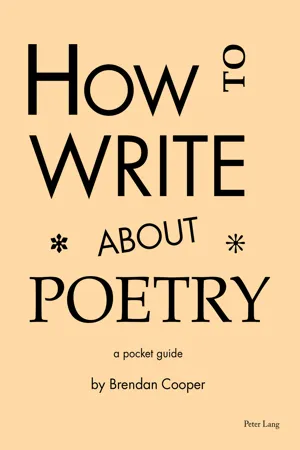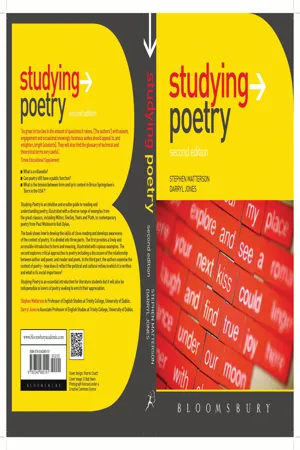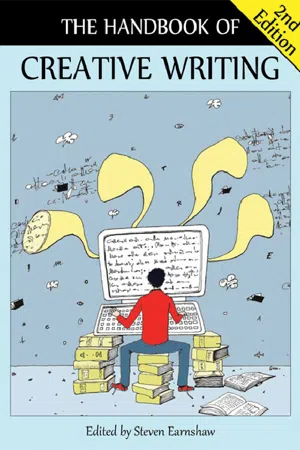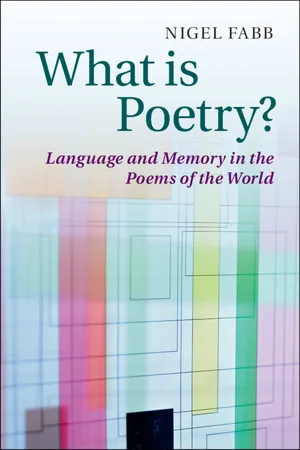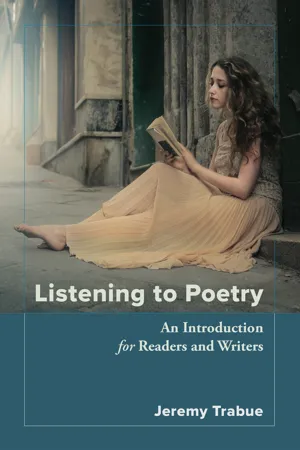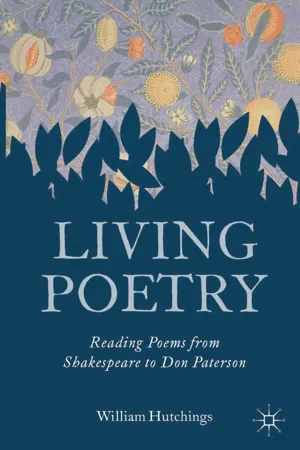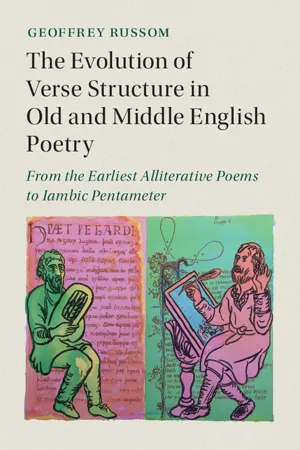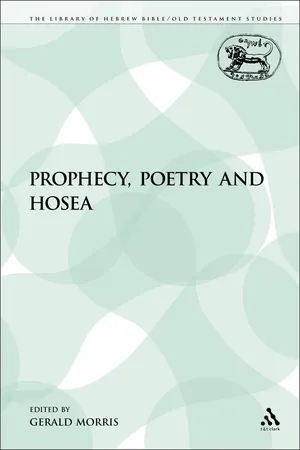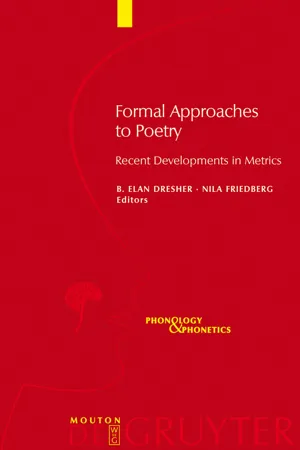Literature
Poetic Form
Poetic form refers to the structure and organization of a poem, including its rhyme scheme, meter, and stanzaic pattern. Different forms, such as sonnets, haikus, and villanelles, have specific rules and conventions that poets use to shape their work. The choice of poetic form can greatly impact the overall meaning and impact of a poem.
Written by Perlego with AI-assistance
Related key terms
1 of 5
12 Key excerpts on "Poetic Form"
- No longer available |Learn more
- Joseph Black, Leonard Conolly, Kate Flint, Isobel Grundy, Don LePan, Roy Liuzza, Jerome McGann, Anne Lake Prescott, Barry Qualls, Claire Waters(Authors)
- 2012(Publication Date)
- Broadview Press(Publisher)
Poetic FormS In poetry, language is intimately related to form, which is the structuring of words within identifiable patterns. In prose we speak of phrases, sentences, and paragraphs; in poetry, we identify structures by lines, stanzas, or complete forms such as the sonnet or the ode (though poetry in complete or blank verse has paragraphs of variable length, not formal stanzas: see below). Rightly handled, the form enhances expression and meaning, just as a frame can define and enhance a painting or photograph. Unlike the photo frame, however, form in poetry is an integral part of the whole work. At one end of the scale, the term “form” may describe the epic, the lengthy narrative governed by such conventions as division into books, a lofty style, and the interplay between human and Reading Poetry 925 supernatural characters. At the other end lies the epigram , a witty and pointed saying whose distinguishing characteristic is its brevity, as in Alexander Pope’s famous couplet, I am his Highness’ dog at Kew; Pray tell me sir, whose dog are you? Between the epic and the epigram lie many other Poetic Forms, such as the sonnet, the ballad, or the ode. “Form” may also describe stanzaic patterns like couplets and quatrains . “ FIXED FORM ” POEMS The best-known Poetic Form is probably the sonnet, the fourteen-line poem inherited from Italy (the word itself is from the Italian sonetto , little song or sound). Within those fourteen lines, whether the poet chooses the “Petrarchan” rhyme scheme or the “English” form (see below in the section on “Rhyme”), the challenge is to develop an idea or situation that must find its statement and its resolution within the strict confines of the sonnet frame. Typically, there is an initial idea, description, or statement of feeling, followed by a “turn” in the thought that takes the reader by surprise, or that casts the situation in an unexpected light. - eBook - PDF
How to Write About Poetry
A Pocket Guide
- Brendan Cooper(Author)
- 2019(Publication Date)
Chapter 3 The Challenge of Poetic Form What is “Poetic Form”? I began this book by claiming that, of all forms of writing that students have to study in English, poetry is most often the most difficult. In fifteen years of teaching literature at university and secondary level, I am very confident that this is accurate. But within the context of studying poetry, there is one area that is usually more challenging than any- thing else: Poetic Form. When asked to consider or analyse “form” in poems, students often find it hard to know where to start. It can be tempting, in such situations, to reduce poems to a kind of elaborate technical exercise. Under pres- sure to find something to say, students can too often fall into the cardinal sin of “feature spotting” – simply identifying the aspects of form in a poem rather than actually analysing them or connecting them to the poem’s meaning. In other words – as the most difficult element of the most difficult form of writing in the subject of English – the question of Poetic Form, and how to analyse it, is a serious one that demands very careful attention. 34 Chapter 3 We might sensibly start with a simple question – what is Poetic Form, exactly? To answer this, let us start with what seems to be a very straightforward sentence: Today I went out to the shops, and bought a loaf of bread. We have here thirteen words, delivered in what feels like a fairly clear, basic fashion. Written out like this, we would call this a sentence of prose. All this really means is language written in sentences as we would normally encounter them in stories, articles, news features, novels, biographies, and the like. Most writing is in prose. This book is in prose, for example. Though it might be a crude way of putting it, it is nevertheless quite useful to think of “prose” as essentially sig- nifying “normal” writing, in the various forms this can take. - eBook - ePub
- Stephen Matterson, Darryl Jones(Authors)
- 2011(Publication Date)
- Bloomsbury Academic(Publisher)
signifieds ). Translation, be it from one language to another, or from one medium to another within the same language, is fraught with perils. As with the above examples, it can be fruitful for analysis, but requires caution.Awareness of form, then, is absolutely crucial if we are to be able to talk about poetry at all, for without this awareness we cannot even account for our recognition that poetry is poetry, rather than prose. Beyond this first stage comes the recognition that Poetic Forms are not neutral entities, each carrying the same value, and hence meaning, as the other. Rather, they can be said to contain their own ideologies, and poetry is often the site of ideological struggle or hidden premises. (As is criticism: the New Critical valorization of the lyric as the dominant Poetic Form is due in part to the fact that the lyric, which can relatively easily be understood as a free-standing verbal object, is teachable in class in a way that, say, the epic or narrative poem is not.) Crudely put, different Poetic Forms mean different things, irrespective of the specifics of individual poems. On a simple level, a reader should instantly know, before a word of the poetry is read or understood, that an ode to Queen Elizabeth II and a limerick about Queen Elizabeth II presuppose radically different attitudes to their subject. The former suggests a serious, celebratory formality and ostentation, the latter jocularity or even hostility; an elegy written about the Queen presupposes that she is dead (or, in the hands of a republican, it might presuppose satire ).Sometimes form and content can be in direct conflict. In 1984, Bruce Springsteen released the song ‘Born in the USA’, a bitter account, realized through the story of a Vietnam veteran, of the state in which America, under the current Reagan administration, found itself: ‘Born down in a dead man’s town / First kick I took was when I hit the ground’ is the song’s opening couplet; its chorus, the obsessively repeated ‘born in the USA!’, was surely intended as a sardonic comment (though, as a later chapter will show, issues of intentionality are notoriously tricky).17 Springsteen’s liberal political stance was a matter of public record, as was his antipathy towards president Ronald Reagan: in 1982, in the middle of Reagan’s first presidential term, Springsteen released Nebraska , a depressing collection which included several Murder Ballads,18 recorded acoustically, in stark contrast to the usual joyous E-Street band arrangements of Springsteen’s songs. In 1984, Reagan was up for re-election, and on the campaign trail in Springsteen’s home state of New Jersey he gave a speech which included the following remark: ‘America’s future rests in a thousand dreams inside your hearts. It rests in the message of hope in the songs of a man so many young Americans admire: New Jersey’s Bruce Springsteen. And helping you make those dreams come true is what this job of mine is all about.’19 - eBook - PDF
- Steven Earnshaw(Author)
- 2014(Publication Date)
- Edinburgh University Press(Publisher)
19 What is Form? W. N. Herbert Iambic pentameter. There now, I’ve said it. Please form an orderly queue to flee from this chapter. What other two words in the poetry world excite such intimidation, boredom, cantankerousness and, yes, passion? (Though ‘reluctantly rejecting’ or ‘talentless guff’ may come close.) ‘Iambic pentameter’ gives off the musty scent of the academy, with perhaps a topnote of formaldehyde – it’s Greek, for God’s sake, though apparently not in the way ‘ouzo meze parakalo’ is Greek. And it functions as shorthand for a host of terrors: metre, stress, stanza, and above all, form. Form consists of all the structural conventions within which most poetry in English has been written inside and outside the last hundred years. It is to the aspiring practitioner of literature as theory is to its critic. It is also the undisputed hero of this essay, even if it is an abstraction. Whether you are a new writer approaching this issue for the first time, a resolute anti-formalist, or someone in their seventh year of fruitless struggle with the trochee, you are haunted by form. If you haven’t got to grips with it, says that over-familiar inner voice, then you’re not serious about this whole poetry business. If your inner voice happens to be Baudelaire, he’s even blunter: ‘I pity the poets who are guided solely by instinct; they seem to me incomplete’ (Auden 1987: 53). If you go to writers’ groups, you’ll find that form bores proliferate with their coronets of sonnets or praise of the amphibrachic foot. You’ll also find their opposites are just as bonkers about their anti-academic performance schtick, their aleatoric principles for gen-erating text, or their Old Believers-type devotion to the ampersand. The temptation to shrug it off, to keep shrugging it off, seems entirely natural; to concentrate instead on the intricate, careful work of giving each poem its own combination of music and structure, according to one’s own principles of rhythm and discipline. - eBook - PDF
What is Poetry?
Language and Memory in the Poems of the World
- Nigel Fabb(Author)
- 2015(Publication Date)
- Cambridge University Press(Publisher)
2 Form This book argues that poetry is divided into sections, such as lines, which are small enough to fit as wholes into a kind of memory with limited capacity, called working memory. In this chapter, I look at Poetic Form and differentiate between those kinds of Poetic Form that depend on this division into small sections, and those kinds of form that do not. I conclude that some component parts of Poetic Form are processed by specialized psychological procedures, some of which apply to sections such as lines, which are held as whole sequences in working memory. Kinds of Poetic Form I suggest there are various distinct kinds of Poetic Form. One kind of form in a poem is its division into sections. A poem is in continuous sections; for example, it can be divided continuously into a sequence of lines. Sections can be on different layers – lower contained within higher. Thus, lines may be contained in stanzas, both of which are kinds of section. A poem is always divided into sections, at least one level of which is not determined by ordinary linguistic form or meaning. Many poems also have forms that are systematically added and are not found systematically in ordinary language. I call these the ‘added forms’, and they include metre, rhyme, alliteration, parallelism and perhaps some other forms. The defining characteristic of what I distinguish as an added form in poetry is that it is predictably present in the text. Many of these forms can be found also in text that is not divided into lines, in which case the forms can only be emergent and occasional, not predictably present. The added forms are always defined relative to the sections of poetry, such as the line. I suggest that each of the added forms of metre, rhyme, alliteration and parallelism should be divided into distinct component parts, which interact to produce the form. This means metre, rhyme, alliteration and parallelism should be treated as ‘modular ’ forms. - eBook - PDF
- Christiana Gregoriou(Author)
- 2017(Publication Date)
- Red Globe Press(Publisher)
CHAPTER 1 Naming Poetic Parts ❚ 1.1 Analysing poetry When it comes to poetry, stylisticians, much like literary critics, are concerned with explaining how the poem’s form and structure contributes to the effects that it generates, and the ways in which the poem expresses the poet’s ideas. However shared their tasks, the two sets of different commentators neverthe-less operate at rather different levels of abstraction (Leech, 1969: 6). As noted in the previous chapter, a stylistician is more concerned with explaining in objec-tive and reliable terms the way in which the language of the poem particularly contributes to its meaning. And it is for this reason that stylisticians often start by outlining their initial impressions of a text, after which they proceed to engage in detailed and systematic linguistic analysis of the art form to justify or explain these original intuitions. But what makes poetry special or different from other literary art forms? The OED defines poetry as the ‘composition in verse or some comparable patterned arrangement of language in which the expression of feelings and ideas is given intensity by the use of distinctive style and rhythm’. What appear to differen-tiate poetry from other imaginative, creative, or indeed fictional literary art forms are the notions of ‘intensity’ or emotional impact, coupled with ‘style’ and ‘rhythm’ in potentially ‘verse’ form. Therefore, one of the things we should consider is how to go about describing these ‘verses’, their ‘rhythm’ and their accompanying ‘intensity’. ❚ 1.2 Rhythm and metre ‘Rhythm’ is something we perceive in many things, such as the beating of our hearts, the sound of a machine, or indeed music. It is essentially a pattern of stresses, the perception human beings have of ‘on’ and ‘off’ beats, strong and weak ones, correspondingly referred to as the ‘ictus’ (/) and the ‘remiss’ (X). - Available until 18 Jan |Learn more
Listening to Poetry
An Introduction for Readers and Writers
- Jeremy Trabue(Author)
- 2019(Publication Date)
- Chemeketa Press(Publisher)
First, the form of a poem is what gives it shape and structure. The main structural elements of a poem are lines and stanzas. The line is the basic unit of the poem, which ends independently of the end of the page. It is part of the structure of the poem. Stanzas are recognizable sets of lines.Second, form is a pattern of formal choices that can be recognized and described. A form may precede a poem—similar to a blueprint or recipe. The more important the form is for the poem, and the more the poem follows rather than generates its own pattern, the more “formal” we say it is. However, even very informal poems still have form in their structure and shape.To finish off the chapter, here’s a list of reminders, tips, and tricks to help you as you work with form in poetry: • Form is seen in patterns, which may be patterns in sound, in appearance, in grammar—almost anything. Look for repetition, sequence, and variation. • Patterns are often found within lines and between lines, and within stanzas and between stanzas. Ends and beginnings are often places to find a pattern and thus a form at work. • Keep your mind open about what constitutes form. Make note of whatever creates structure, even strong patterns in content. Count whatever you can count. • Pay attention to the title! Formal poems often label themselves.• Use reference materials to match the patterns you see to received forms. The internet makes finding these forms easy, but Appendix A of this very book is a guide to the most common received forms. Start there! There are also many other print references on the subject.• If you can identify a poem as being in or related to a received form, try searching online for a few other examples of the form and compare.• The uniquely intense and complex relationship between form and content is one of the things that gives poetry so much energy and makes it distinct from other art forms. Understanding and appreciating this interplay can be a little odd, or feel alien, if it’s not something you’re used to paying attention to. But if it feels that way, stick with it. You will get used to it, and, hopefully, come to find it fascinating. - eBook - PDF
Living Poetry
Reading Poems from Shakespeare to Don Paterson
- William Hutchings(Author)
- 2012(Publication Date)
- Bloomsbury Academic(Publisher)
Part One Elements of Poetry 2 Form and Technique Poetry is not the thing said but a way of saying it. (A. E. Housman) 1 The materials of poetry are words. Poems are created step by step, by building words into structures, beginning with the phrases and clauses that make up the lines, stanzas and other formal sections. A poet – the word derives from the Greek meaning ‘maker’ – con-structs the whole from these parts. It is with this etymology that George Puttenham began his highly significant and influential tract in the development of English rhetoric and poetics, The Arte of English Poesie , published in 1589: ‘A poet is as much to say as a maker.’ 2 Poets’ techniques, the skills they employ in the service of their craft, lie in selecting their material and then shaping it into an expressive work of art. In this chapter we shall look at examples of poets’ handling of these elements, beginning with individual words and building gradually into formal sections of a poem. 2.1 The word A word is the smallest unit of meaning. Syllables and even individ-ual letters can have a purpose within the aural structure of a longer section of writing, but selection of words is the writer’s first step towards expression of thought or feeling. It is, indeed, often the case that we can observe the essence of a poet in her or his range of 13 14 Living Poetry vocabulary. We here look at three examples. Andrew Marvell locates his meaning in the choice and definition of individual words: he is a poet of the concise and the precise. Shakespeare’s sonnets use lan-guage in multiple and shifting ways. His words slide around to create complex and sometimes uncertain textures of meaning. Alexander Pope uses language with Marvell’s precision, but the significance of his key words is often fully revealed only by observing their position within the structure of the whole poem. - eBook - PDF
The Evolution of Verse Structure in Old and Middle English Poetry
From the Earliest Alliterative Poems to Iambic Pentameter
- Geoffrey Russom(Author)
- 2017(Publication Date)
- Cambridge University Press(Publisher)
chapter 1 General Principles of Poetic Form 1.1 Metrics, Linguistics, and Literary Creation A widely used history of English discusses the structure of the modern language before tracing its descent from its oldest ancestor, Proto-Indo-European. 1 This design introduces essential linguistic concepts with familiar examples. Comparison of English with languages like Sanskrit, Armenian, and Gaelic then highlights shared features discovered by historical linguists. Comparison with languages like Chinese and Hebrew distinguishes features due to com- mon Indo-European origin from features also present in unrelated languages. I have adopted a similar design in this book, which introduces metrical concepts with Modern English examples, compares English poetry with poetry in other languages, then traces the evolution of English meters from prehistory to the Modern English period. Work on linguistic universals, which began in earnest during the 1960s, has made it easier to analyze a newly discovered language or an ancient language preserved in written form. 2 Since the foundational work of Chomsky, researchers have been testing proposed universals against a representative sample of the world’s languages. 3 We are now better equipped to identify what is English about English and what is simply human. I hope to persuade linguists that a universalist theory of meter makes a useful addition to established linguistic sub-fields. Historical linguists, of course, have always relied on metrical rules for analysis of languages with no living speakers. An 1885 study of Old English meter provided an indispensable foundation for research on the evolution of English. 4 Use of metrical evidence has been rudimentary for the most part, however, drawing on obvious requirements of a particular verse form. - Whilst the reader might want to argue that the stanza is not really a visual effect, certainly not of the kind we have discussed so far, it matters here because all stanzaic forms when ren-dered in print address themselves to the reading eye. Even people supposedly well informed about poetry (such as the authors of this book) would be hard put to give an accurate description of a poem’s stanzaic form merely through hearing the work being read aloud. A poem’s stanzaic form is most evident when it is encountered in its visual dimension. 34 Poetry Perhaps the most notable aspect of the visual organisation of poetry on the printed page is the division of many poems into groups of lines, or ‘stanzas’: She dwelt among the untrodden ways Beside the springs of Dove, A Maid whom there were none to praise And very few to love: A violet by a mossy stone Half hidden from the eye! Fair as a star, when only one Is shining in the sky. She lived unknown, and few could know When Lucy ceased to be; But she is in her grave, and oh, The difference to me! (Wordsworth) A stanza is a subdivision or section of a poem, and a poem’s stanzas generally share the same line-length, rhyme scheme and poetic metre. Pauses between stanzas are marked by a space line on the printed page. A poem divided into stanzas is thus referred to as ‘stanzaic’. The term ‘verse’ is not infrequently used for stanza, especially with reference to the lyrics of pop songs or hymns, but should perhaps be avoided, given that a verse is more properly a single line of a poem.
- eBook - PDF
- Gerald Morris(Author)
- 1996(Publication Date)
- Sheffield Academic Press(Publisher)
Poetry Defined as the Meeting of Sound and Sense By far the most frequently proposed definition of poetry, and in many ways the most persuasive, is that poetry represents a middle ground between music (sound without verbal meaning) and discourse (meaning without attention to sound). In poetry, both the sound (the 'rhythmic aspect') and the sense (the 'semantic aspect') are important. 59 At different historical periods, one aspect would be elevated above the other, but both elements are necessary, or the work is not poetry. On the one hand, this means that the semantic meaning of the poem is alone insufficient. The poem's meaning should be reflected by the rhythmic aspect as well. Alexander Pope writes: True Ease in Writing comes from Art, not Chance, As those move easiest who have learn'd to dance. 'Tis not enough no Harshness gives Offence, The Sound must seem an Eccho to the Sense. 57. R. Jakobson, 'Linguistics and Poetics', in Pomorska and Rudy (eds.), Language in Literature, p. 71. 58. R. Jakobson, 'Poetry of Grammar and Grammar of Poetry', in Pomorska and Rudy (eds.), Language in Literature, p. 127. 59. The terms belong to O.M. Brik, 'Contributions to the Study of Verse Language', in L. Matejka and K. Pomorska (eds.), Readings in Russian Poetics; Formalist and Structuralist Views (trans. C.H. Severens; Cambridge, MA: Massachusetts Institute of Technology Press, 1971), p. 119. 2. Rhetoric and Poetry 37 Then the virtuoso demonstrates at length. For instance: When Ajax strives, some Rock's vast Weight to throw, The Line too labours, and the Words move slow, Not so when swift Camilla scours the Plain, Flies o'er th'unbending Corn, and skims along the Main. 60 This correlation of the 'rhythmic aspect' with the literal semantic meaning of the poem has been noted by many critics. Northrop Frye refers to it as 'imitative harmony' and describes its use in poetry from Homer to Milton. 61 Wimsatt's book The Verbal Icon takes its title from a similar picture of poetry. - eBook - PDF
Formal Approaches to Poetry
Recent Developments in Metrics
- B. Elan Dresher, Nila Friedberg, B. Elan Dresher, Nila Friedberg(Authors)
- 2008(Publication Date)
- De Gruyter Mouton(Publisher)
Language and Literature 12: 73–80. 90 Nigel Fabb 2003 Metrical form in poetry requires lineation but metrical form in music does not. Words and Music Conference, University of Missouri-Co-lumbia 2004 Form as ction. Belgian Journal of English Language and Literature New series 2: 63–73. Fabb, Nigel, and Morris Halle in press a Metrical complexity in Christina Rossetti’s verse. College Literature. Fabb, Nigel, and Morris Halle in press b Telling the numbers: a uni ed account of syllabo-tonic English and syllabic Polish and French verse. Research in Language. Fabb, Nigel, and Morris Halle in prep. A Treatise on Meter. Fuller, J. 2000 The Oxford Book of Sonnets. London: Oxford University Press. Halle, Morris, and Samuel Jay Keyser 1971 English Stress. Its Form, Its Growth and Its Role in Verse. New York: Harper and Row. Halle, Morris, and Samuel Jay Keyser 1999 On meter in general and on Robert Frost’s loose iambics in particular. In Linguistics: In Search of the Human Mind. A Festschrift for Kazuko Inoue, M. Muraki and E. Iwamoto (eds.), 130–153. Tokyo: Kaitaku-sha. Hayes, Bruce 1989 The prosodic hierarchy in meter. In Phonetics and Phonology 1: Rhythm and Meter , Paul Kiparsky and G. Youmans (eds.), 201–160. San Diego: Academic Press. Idsardi, W. 1992 The computation of stress. PhD dissertation, MIT. Jakobson, R. 1960 Concluding statement: linguistics and poetics. In Style in Language , T.A. Sebeok (ed.), Cambridge, MA: MIT Press. Johnson, John W. 1996 Musico-moro-syllabic relationships in the scansion of Somali oral poetry. In Voice and Power. The Culture of Language in North-East Africa , R. J. Hayward and I. M. Lewis (eds.), 73–82. London: School of Oriental and African Studies. Keith, A. B. 1920 A History of Sanskrit Literature . London: Oxford University Press. Generated metrical form and implied metrical form 91 King James VI 1584 Ane Schort Treatise Conteining some Reulis and Cautelis to be Obse-ruit and Eschewit in Scottis Poesie.
Index pages curate the most relevant extracts from our library of academic textbooks. They’ve been created using an in-house natural language model (NLM), each adding context and meaning to key research topics.

